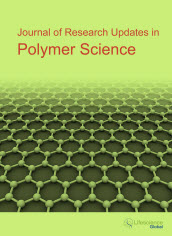jrups
Abstract : New Polymer Syntheses Part: 55#. Novel Conducting Arylidene Polymers and Copolymers Based on Methyl-Cyclohexanone Moiety
|
|
Abstract: A new interesting class of conducting polymers based on methyl-cyclohexanone in the polymer main chain has been synthesized by solution polycondensation of terephthalaldehyde with methyl-cyclohexanone. Copolymers containing different cycloalkanone moieties were also synthesized using solution polycondensation technique. The model compound I was synthesized by the interaction of methyl-cyclohexanone monomer with benzaldehyde, and its structure was confirmed by elemental and spectral analyses. The resulting new polymers and copolymers were characterized by elemental and spectral analyses, beside solubility and viscometry measurements. The thermal properties of those polymer and copolymers were evaluated by TGA, DrTGA and DTA measurements and correlated to their structural units. PDT as well as T10 was in the range from 205 to 370 ºC. In addition, T10 thermal stability for all the polymers was in theorder: VI> II > III > IV > V. X– ray analysis showed that it has some degree of crystallinity in the region 2q = 5 – 60 degree.The UV– visible spectra of some selected polymers were measured in DMSO solution and showed absorption bands in the range 265-397 nm, due to n – p* and p – p* transition. The morphological properties of copolymer IV as selected examples were tested by SEM. The electrical conductivities of the synthesized polymers and copolymers enhanced to become in the range of 10-9-10-8 S cm-1 by doping with iodine. Keywords: Synthesis, Characterization, Polycondensation, Conducting Polymers, Conducting Copolymers. Download Full Article |
Abstract : Fabrication of Hollow Microspheres Using Single Step Electrospraying Process
|
|
Abstract: In this study, a single step method for large scale fabrication of hollow microspheres with a narrow size distribution is presented. PolyBenzoThiadiazole (PolyBT), a conducting polymer, was electrosprayed at high voltage to obtain microspheres. Hollow spheres of size ranging from 4.1 to 7.3 µm were observed through scanning electron microscope images, without any chemical degradation as shown by FTIR studies. In addition, these microspheres demonstrated a change in optical and hydrophobic properties as exhibited by the UV-visible and contact angle measurements. Thus providing interesting opportunities for use in biomedical applications, sensors as well as optoelectronic devices. Keywords: Conducting polymers, Electrospraying, Hollow microspheres, PolyBenzoThiadiazole (PolyBT). Download Full Article |
Abstract : The Solid State 13C NMR Study of Gamma Radiation of Ethylene-Octene Copolymer
|
|
Abstract: Ethylene-octene copolymer (POE) samples exposed to γ-radiation under a series of absorbed doses have been investigated using thermal analysis, sol–gel analysis and solid state 13C nuclear magneticResonance (NMR). The chemical shift of POE was assigned and peak evolution as a function of radiation dose was discussed. An obviously evolution is that the peak area of 33.6 ppm decreases as a function of the increase of radiation dose, and at the same time, the peak shape broadens gradually. This indicates that the chain scission occurred between α-C and branch chain C (methine) or between C1 (the sidegroup hexyl) and branch chain C (methane) after radiation. The chain scission is severer with the increase of absorbed dose.The 13C NMR spectra of the corresponding gels confirmed the result. The variation in linewidth of the resonance at 33.6 ppm in samples of POE irradiated to different doses was attributed to information of chain, scission, new cross linking, and crystalline components. Keywords: Ethylene-octene copolymer (POE), γ-radiation, solid-state 13C NMR, Chain Scission. Download Full Article |
Abstract : Modification of Nanocrystalline Cellulose for Bioactive Loaded Films
|
|
Abstract: Despite the use of petrochemical derived packaging, many problems such as browning and food spoilage still happen in food after harvesting. There is an increasing consumers concern for food shelf life to be extended as much as possible along with a big interest in green and bioactive materials, that could be used in direct contact with aliments. In order to reach public demand, biopolymers coming from natural sources such as plants or animals have been used to replace synthetic materials. Even though natural polymers are biodegradable, they do not reach regulations required with respect to mechanical properties in commercial applications. However, the mechanical properties can be improved when reinforced with nanoparticles. Several reinforcing nanoparticulessuch as clays, silica or silver have been used for industrial applications, but cellulose nanocrystals (CNCs) are a better choice for food industry due to their biodegradable and biocompatible nature as well as their outstanding potential in improving mechanical and barrier properties of nanocomposites. CNCs consist of anhydroglucopyranose units (AGU) linked together and several functional hydroxyl groups found on its surface. Modifications of the CNC surface chemistry can give to cellulose new functionalities that open the way to the development of new bioactive reinforcement in food packaging. The present review will be focused on covalent and non covalent modifications that can be achieved on surface CNC with the aim of adding functionalities to be applied for food industry. Keywords: Food packaging, cellulose nanocrystals, CNC, acetylation, polymer grafting, TEMPO oxidation, layer-by-layer, cationic surfactants, radiation-induced polymer grafting. Download Full Article |






















